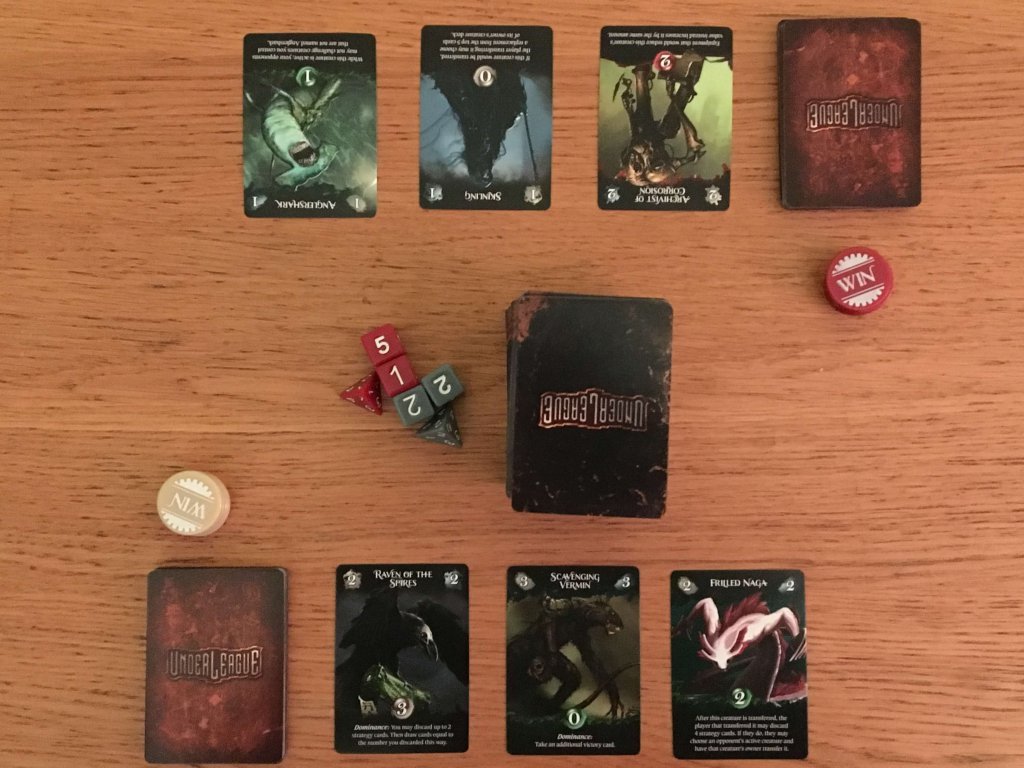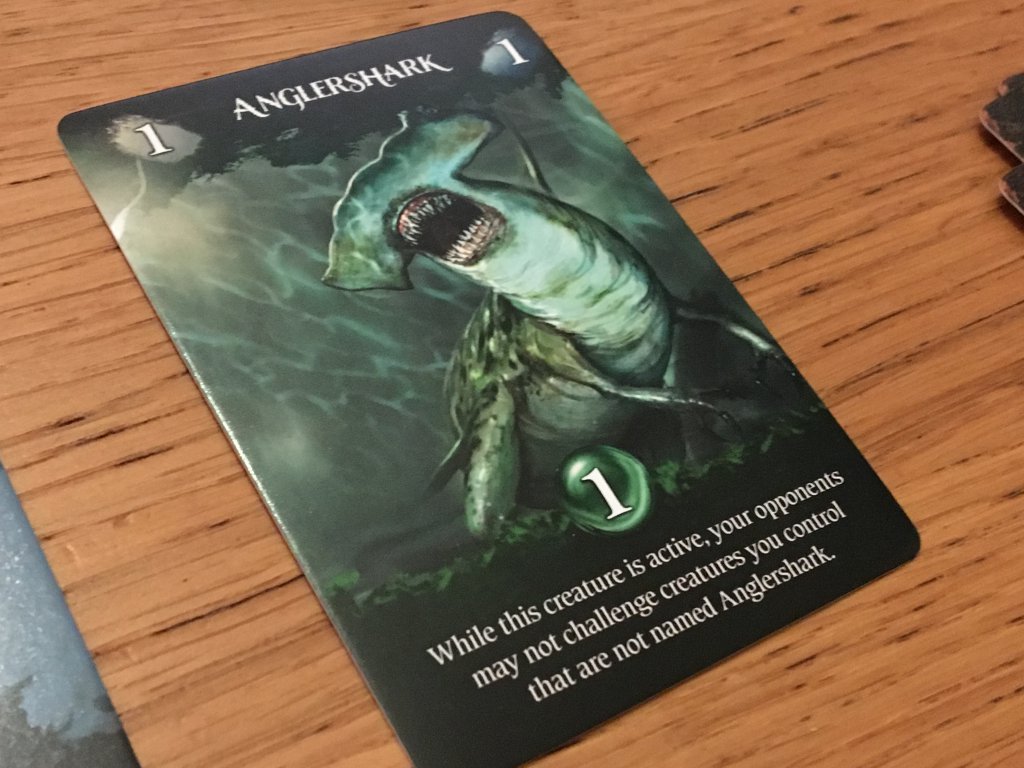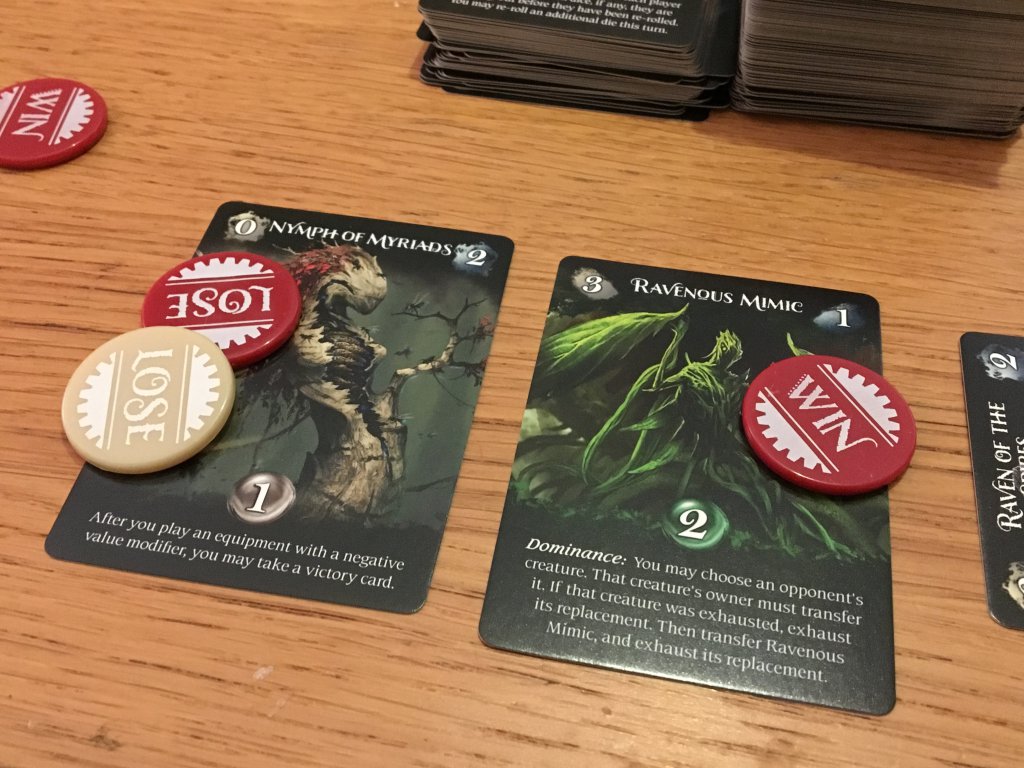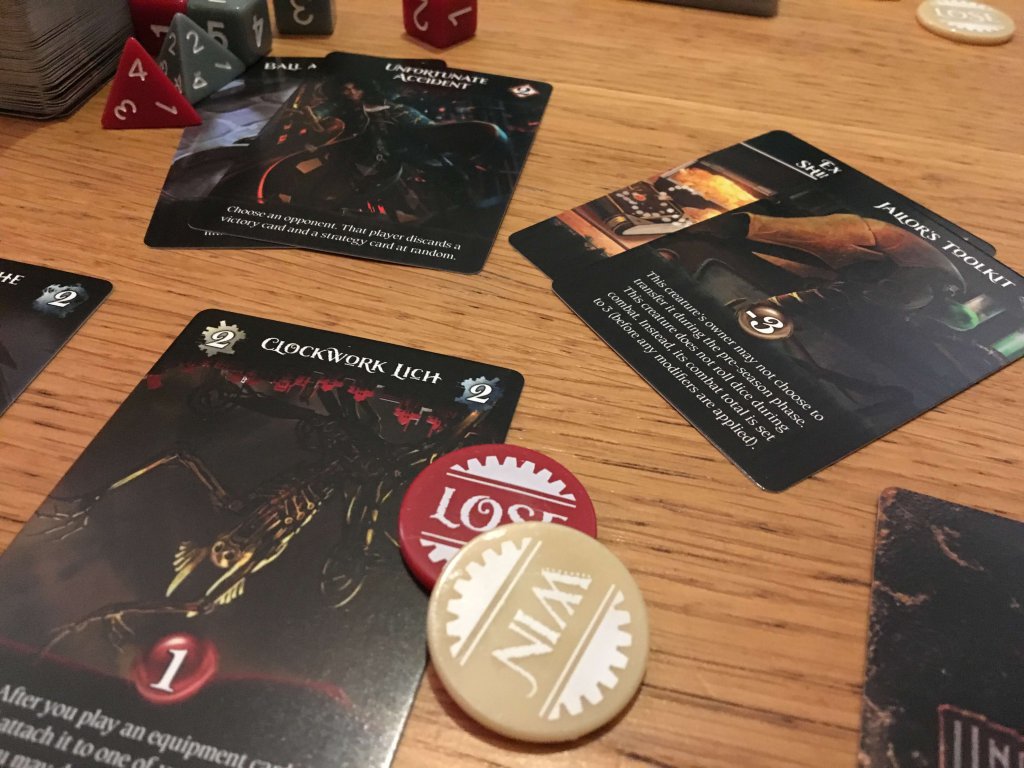Underleague — Are you not entertained?
In the fantasy city of Helgarten, illegal combat bouts mechanical abominations against cruel and outlandish hybrid creatures in a pit fight known as The Underleague.
A game for two to five players (that works by far the best at two or four) Underleague draws inspiration from high fantasy for its theme and Magic: The Gathering for its mechanics. More than just a clone of other games however, it uses gambling and deckbuilding variants to keep things interesting.
Underleague is the product of debutant designer Fergus Blair and his company Cogwright Games. Considering their newness to the market, Underleague cuts a reasonably striking figure, with good production throughout and artwork that feels familiar — its iconic Anglershark creature is a clear ripoff of Return to Ravnica’s Shambleshark — but nonetheless impressive. The sheer number of cards (over 300) adds to the feeling that Underleague offers good value for money.
This huge number of cards is unfortunately one of the only real criticisms I have of the game, so to get that out of the way early, I’ll explain a bit more about the structure of the game. Underleague has players in charge of identical decks of thirty creatures, which are shuffled and drawn into their hand secretly. In addition, a Strategy Deck made up of 250 of the cards in Underleague will be placed in the centre, from which both players will draw items and schemes.
My complaint is simply this — 250 cards that need to be shuffled together and placed on a table. Really? It’s more frustrating than anything else, but on numerous occasions during shuffling, I’ve thrown the cards all over, whilst on other occasions during play, the stack was knocked over. A house rule to have two or more draw decks (since random is random or should be) made the most sense to me, but that’s obviously up to you.
With this rant out of the way, I should also mention that Underleague curiously contains a few other components. Six dice in two colours (red and grey) and five betting chips for each side are also in there, the latter of which show “Win” on one side and “Lose” on the other. This, as I’ll discuss later, is because players are by no means limited to backing their own creatures. This is Underleague, afterall, and in these back alley fights all is never quite as simple as it might appear to be.
When the game begins, Underleague is simple, but pleasingly unusual. On their turn, a player simply draws five strategy cards (from the central deck) and then three creature cards from their deck. From the three creatures, they choose one and put it face down on the table. The other two go to the bottom of their deck and then this process is repeated twice more, giving each player three face down creatures and a strategy hand of five cards. At this point, the three creatures on each side are simultaneously flipped face up for comparison.
The main turns in Underleague are split into three phases — Preseason, Betting and Combat. In Preseason, players will draw two Strategy cards plus one for each bet they won in the previous round. If either player controls three creatures of the same kind, then they will draw a bonus card. A few bits of housekeeping are also done here — resetting and occasionally, exchanging creatures for one from the top of the personal draw deck.
During the Betting phase, each player takes their five betting chips and bets on which creatures will win or lose. Creatures may have a bet token from either sides on them (and those tokens may show the same outcome) but neither player can bet two of their own tokens on the same creature. To be clear here, players can bet on creatures on either side — their own or their opponents.
When Combat rolls around, the players take turns to challenge each other by choosing a creature and declaring whether it is day or night. Creatures have different values for fighting at either time of day, meaning that in conjunction with the betting tokens, players can engineer advantageous situations — whether that be to win or lose. Depending on what is shown on the card, the creatures will then roll off, with an interesting twist being that the stronger creatures roll a better set of dice (D3, D4 and D6 feature in the game) but are by no means guaranteed to win.
Affecting the battle comes down to equipped items and schemes played from hand, which can affect the outcome either based on an ongoing effect (equipment) or something unseen that changes the rules of the scenario. If a challenger wins a fight, then they will claim a victory point (and the first to twenty VP’s wins) and can commit the losing creature by turning it sideways. Defenders that win don’t gain VP, but their creature remains uncommitted, allowing it to be used to retaliate.
The combat in Underleague is the real strength, aside from the excellent artwork and immersive theme that comes with it. The combat is as intense and exciting as it is in any powerful card battle system, but the betting drives considerable advantage by allowing extra cards to be drawn. As any Magic: The Gathering player will know, card advantage is huge and it can easily change the tide of a battle.
Being able to bet on creatures from either side is what makes this system so, so sweet. Imagine if you’re in a situation where two of your creatures are weaker and you have three or fewer cards than your opponent. In most games, you’d be certain to lose those combats and slip to a worse board state, but in Underleague you can bet on your creatures to lose and your opponents to win — so even when the loss happens, you will likely draw enough cards to take the advantage next turn.
The fact that each player has an identical deck of cards is also interesting (I haven’t played with the deck construction variant) and I love the variety of creatures and the closeness of their strength levels. Again, when it comes to resolving combat, Underleague remains tense due to the dice system. Let me explain this briefly — a strength 1 creature rolls a D6, whilst a strength two creature rolls a D6 plus a D4. A strength three creature rolls a D6 plus a D4 and a D3. This gives each incrementally stronger attack an edge, but even a strength three attack can be out-rolled by a strength one attack that rolls high.
Add into this mix the 250 equipment and scheme cards (which are fairly varied, but do feature some repetition) and you have a situation where players can really plan their whole turn based on the combats that they wish to win and lose. Of course, the opposing player will influence the outcome with their own plans, so there’s always both a strategic and a tactical element to consider.
From the production to the gameplay mechanics, Underleague represents a superb design and production debut from Fergus Blair and Cogwright Games. The artwork and production are as good as any top tier publisher would hope to achieve, whilst the design itself is simple, clean and very exciting. The only snag, as I mentioned, is that huge deck — but it’s such an easy problem to mitigate. If you’re a fan of card combat games, you owe it to yourself to check out Underleague.
Underleague is available for purchase on Amazon.co.uk. You can find out more about it on the website of publisher Cogwright Games.
Love board games? Check out our list of the top board games we’ve reviewed.





Comments are closed.